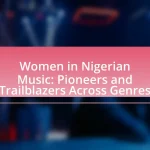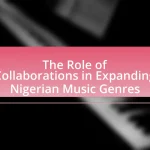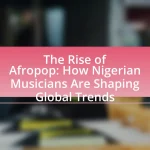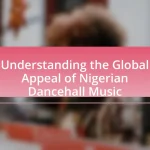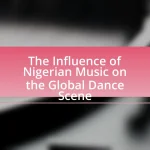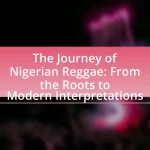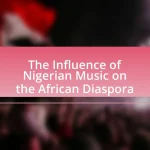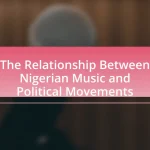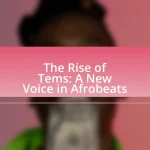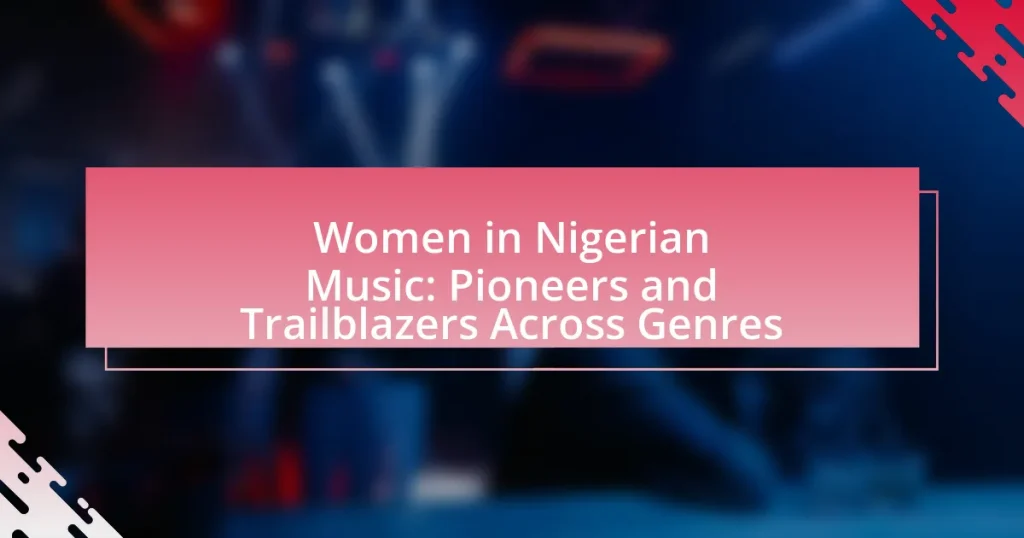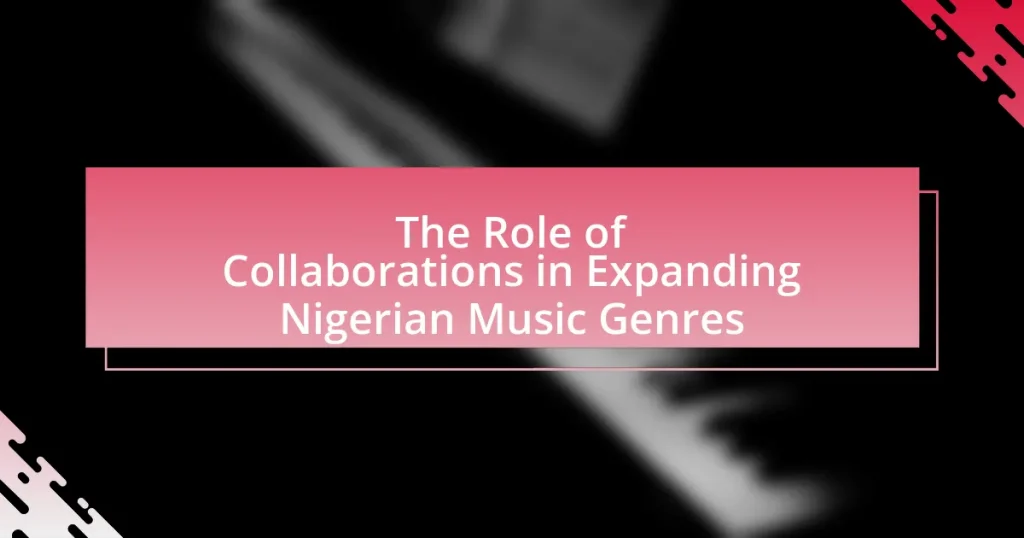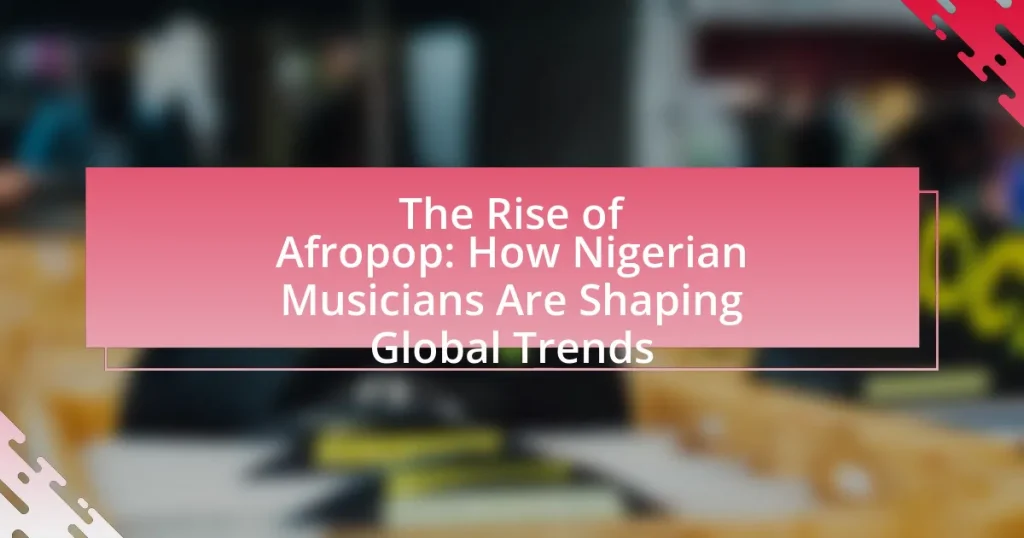The article explores the fusion of traditional Nigerian sounds with modern genres, highlighting how indigenous musical elements are blended with contemporary styles such as hip-hop, R&B, and electronic dance music. It traces the origins of this fusion to the late 20th century, influenced by Afrobeat and cultural exchanges during the colonial and post-independence eras. Key characteristics of traditional Nigerian music, including unique rhythms and instruments, are examined alongside the impact of this fusion on the global music industry, showcasing successful artists like Burna Boy and Wizkid. The article also addresses the challenges artists face in merging these musical traditions while promoting cultural preservation and innovation.
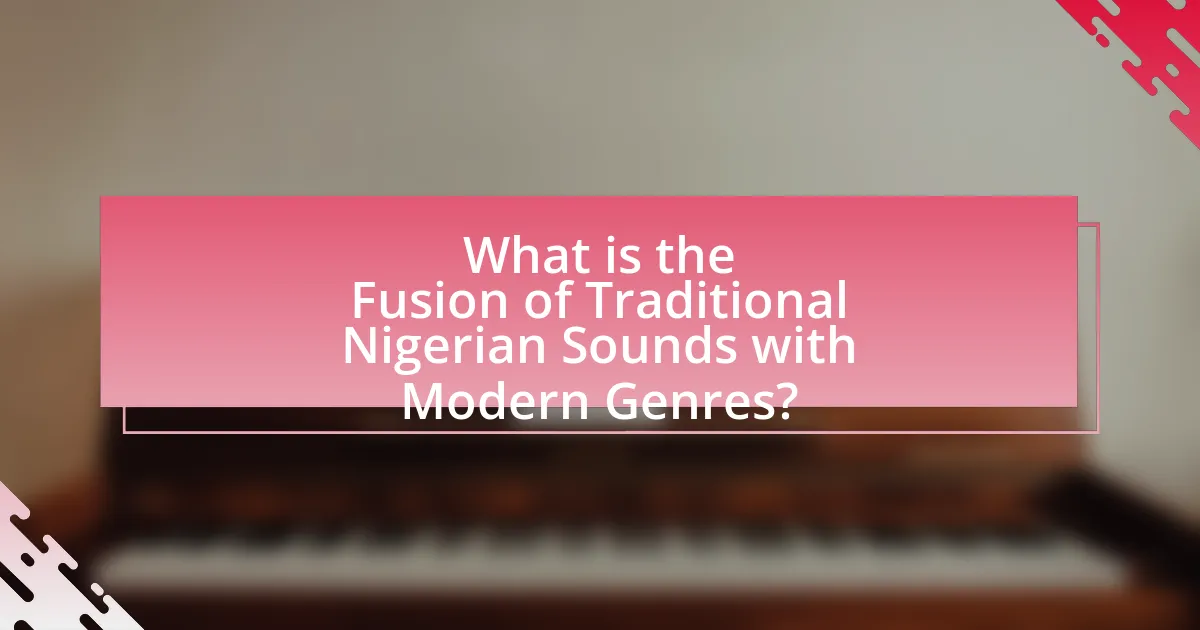
What is the Fusion of Traditional Nigerian Sounds with Modern Genres?
The fusion of traditional Nigerian sounds with modern genres involves the blending of indigenous musical elements, such as rhythms, instruments, and vocal styles, with contemporary music forms like hip-hop, R&B, and electronic dance music. This integration creates a unique sound that reflects Nigeria’s rich cultural heritage while appealing to global audiences. For instance, artists like Burna Boy and Wizkid incorporate traditional African instruments, such as the talking drum and shekere, into their music, enhancing the modern beats with cultural authenticity. This trend has gained international recognition, evidenced by Burna Boy’s Grammy Award win for Best World Music Album in 2020, showcasing the global impact of this musical fusion.
How did the fusion of traditional Nigerian sounds and modern genres begin?
The fusion of traditional Nigerian sounds and modern genres began in the late 20th century as artists sought to innovate and blend indigenous musical elements with contemporary styles. This movement was significantly influenced by the rise of Afrobeat, pioneered by Fela Kuti, who incorporated traditional African rhythms and instruments with jazz, funk, and highlife. The globalization of music through technology and media further facilitated this fusion, allowing Nigerian musicians to access and integrate diverse influences, leading to the emergence of genres like Afropop and hip-hop that reflect both traditional and modern sensibilities.
What historical influences contributed to this fusion?
The fusion of traditional Nigerian sounds with modern genres is significantly influenced by the historical interactions between indigenous cultures and external forces, particularly during the colonial period and post-independence era. The introduction of Western musical styles, such as jazz and rock, during the colonial period led to a blending of local rhythms and instruments with these new influences, resulting in genres like Afrobeat and Highlife. Additionally, the migration of Nigerians to urban centers and abroad facilitated cultural exchanges that further enriched the musical landscape. The rise of technology and media in the late 20th century also played a crucial role, allowing for the dissemination of diverse musical styles and the incorporation of global trends into local music.
How have cultural exchanges shaped the evolution of this music?
Cultural exchanges have significantly shaped the evolution of music by facilitating the integration of traditional Nigerian sounds with modern genres. This fusion has led to the creation of new musical styles, such as Afrobeats, which blends indigenous rhythms with elements of hip-hop, jazz, and electronic music. For instance, the incorporation of Western instruments and production techniques has transformed traditional Nigerian music, allowing it to reach global audiences and influence artists worldwide. The collaboration between Nigerian musicians and international artists has further enriched this evolution, exemplified by the success of artists like Burna Boy and Wizkid, who have gained international acclaim by merging local sounds with global music trends.
What are the key characteristics of traditional Nigerian sounds?
Traditional Nigerian sounds are characterized by their rich rhythmic patterns, diverse instrumentation, and cultural storytelling. The rhythmic complexity often includes polyrhythms, which are foundational in genres like Afrobeat and Highlife. Instruments such as the talking drum, shekere, and various flutes are commonly used, each contributing unique tonal qualities. Additionally, traditional Nigerian music frequently incorporates call-and-response vocal techniques, which enhance communal participation and storytelling. This emphasis on rhythm, instrumentation, and vocal interaction reflects the cultural heritage and social functions of music in Nigerian society.
What instruments are commonly used in traditional Nigerian music?
Traditional Nigerian music commonly utilizes instruments such as the talking drum, shekere, and udu. The talking drum, known for its ability to mimic human speech, is central to many Nigerian musical forms, particularly in the Yoruba culture. The shekere, a percussion instrument made from a gourd covered with a net of beads, adds rhythmic texture to performances. The udu, a clay pot drum, is significant in the Igbo tradition and produces a unique sound that enhances vocal performances. These instruments are integral to the rich tapestry of Nigeria’s musical heritage, reflecting the diverse cultural influences across the country.
How do rhythms and melodies differ across various Nigerian cultures?
Rhythms and melodies differ significantly across various Nigerian cultures, reflecting the diverse ethnic groups and their unique musical traditions. For instance, the Yoruba culture is characterized by complex polyrhythms and call-and-response patterns, often accompanied by traditional instruments like the talking drum. In contrast, the Igbo culture emphasizes a more straightforward rhythmic structure, often utilizing the ogene (a type of gong) and other percussion instruments to create a steady beat. Additionally, the Hausa culture incorporates melodic elements influenced by Islamic traditions, featuring the use of string instruments like the kontigi. These differences are rooted in historical contexts, social functions, and cultural practices, showcasing Nigeria’s rich musical tapestry.
What modern genres are commonly fused with traditional Nigerian sounds?
Modern genres commonly fused with traditional Nigerian sounds include Afrobeats, hip-hop, and reggae. Afrobeats, characterized by its rhythmic and melodic elements, incorporates traditional Nigerian music styles such as highlife and juju. Hip-hop artists in Nigeria often blend indigenous sounds and languages with contemporary beats, creating a unique fusion that resonates with local and global audiences. Reggae music also finds synergy with traditional Nigerian rhythms, often addressing social issues while maintaining cultural authenticity. This fusion reflects the dynamic nature of Nigeria’s music scene, where artists continuously innovate by merging diverse influences.
How does Afrobeat incorporate traditional elements?
Afrobeat incorporates traditional elements primarily through the use of indigenous rhythms, instruments, and musical structures. The genre blends West African musical traditions, particularly Yoruba music, with jazz, funk, and highlife, creating a unique sound. Traditional instruments such as the talking drum, shekere, and various percussion instruments are integral to Afrobeat, providing a rhythmic foundation that reflects cultural heritage. Additionally, Afrobeat often features call-and-response vocal patterns, a hallmark of traditional African music, which enhances its communal and participatory nature. This fusion not only preserves traditional sounds but also revitalizes them within a contemporary context, making Afrobeat a dynamic representation of Nigeria’s musical evolution.
What role does hip-hop play in the fusion of these sounds?
Hip-hop serves as a crucial catalyst in the fusion of traditional Nigerian sounds with modern genres by providing a platform for innovative expression and cultural exchange. This genre incorporates elements such as rhythm, beats, and lyrical storytelling, which resonate with traditional Nigerian music forms like Afrobeats and Highlife. The collaboration between hip-hop artists and traditional musicians has led to the creation of hybrid styles, exemplified by artists like Olamide and Nasty C, who blend indigenous sounds with contemporary hip-hop beats. This fusion not only revitalizes traditional music but also broadens its appeal to global audiences, thereby enhancing cultural visibility and appreciation.
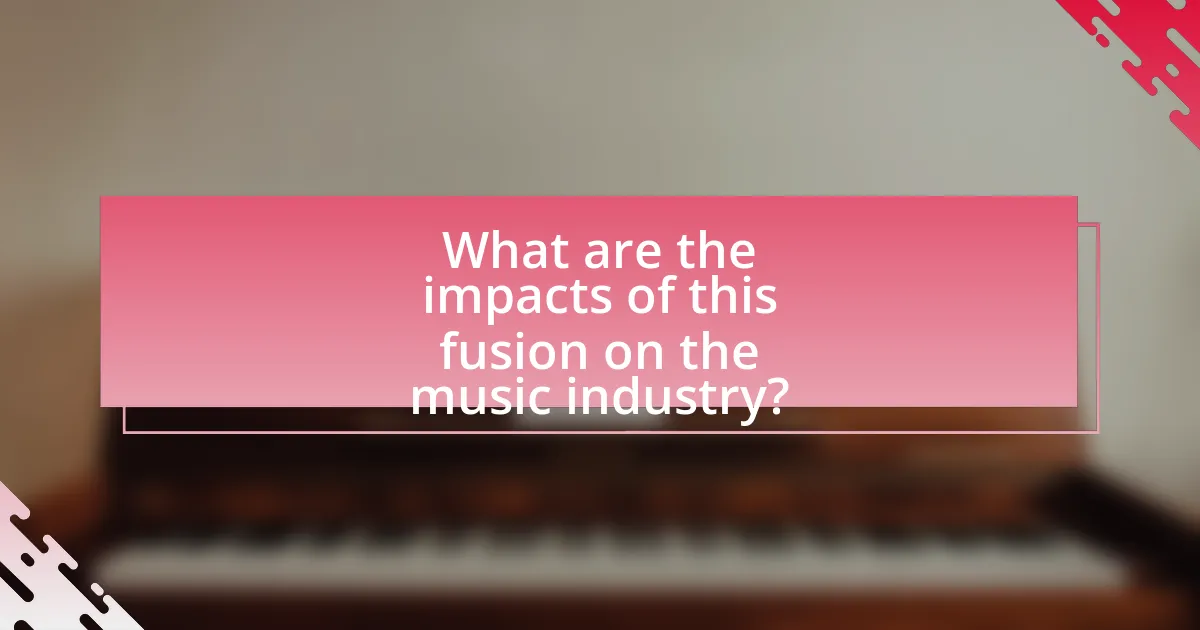
What are the impacts of this fusion on the music industry?
The fusion of traditional Nigerian sounds with modern genres significantly impacts the music industry by broadening its audience and enhancing cultural exchange. This integration allows for the creation of innovative music styles, such as Afrobeats, which have gained international popularity, evidenced by artists like Burna Boy and Wizkid achieving global chart success. The blending of these musical elements not only revitalizes traditional sounds but also attracts diverse listeners, leading to increased streaming and sales. Furthermore, this fusion fosters collaborations between artists from different backgrounds, promoting cross-cultural partnerships and expanding the global reach of Nigerian music.
How has the fusion influenced the global perception of Nigerian music?
The fusion of traditional Nigerian sounds with modern genres has significantly enhanced the global perception of Nigerian music by showcasing its diversity and cultural richness. This blending has led to the emergence of genres like Afrobeats, which combines elements of highlife, hip-hop, and dancehall, making Nigerian music more accessible and appealing to international audiences. The global success of artists such as Burna Boy and Wizkid, who incorporate traditional rhythms and contemporary styles, has further solidified Nigeria’s position in the global music scene. For instance, Burna Boy’s album “African Giant” received a Grammy nomination, highlighting the international recognition of Nigerian music’s fusion. This cultural exchange not only promotes Nigerian artists but also fosters a greater appreciation for African music worldwide.
What are some notable international collaborations that highlight this fusion?
Notable international collaborations that highlight the fusion of traditional Nigerian sounds with modern genres include the partnership between Nigerian artist Burna Boy and American musician Beyoncé on the track “Brown Skin Girl,” which showcases Afrobeat influences blended with contemporary R&B. Another significant collaboration is between Wizkid and Drake on the song “One Dance,” where elements of Afrobeats are integrated into a global pop sound, achieving widespread acclaim and commercial success. Additionally, the collaboration between Tiwa Savage and American rapper Nas on “The One” exemplifies the merging of Nigerian musical heritage with hip-hop, further emphasizing the global appeal of this fusion. These collaborations not only reflect the blending of musical styles but also contribute to the global recognition of Nigerian music.
How has this fusion contributed to the rise of Nigerian artists on the global stage?
The fusion of traditional Nigerian sounds with modern genres has significantly elevated Nigerian artists on the global stage by creating a unique musical identity that resonates with diverse audiences. This blend has led to the emergence of genres like Afrobeats, which combines elements of highlife, juju, and hip-hop, making Nigerian music more accessible and appealing internationally. For instance, artists like Burna Boy and Wizkid have achieved global recognition, with Burna Boy winning a Grammy Award for Best World Music Album in 2021, showcasing the international acceptance of this fusion. Additionally, the collaboration between Nigerian artists and global music icons has further amplified their reach, as seen in Wizkid’s collaboration with Drake on “One Dance,” which topped charts worldwide. This strategic fusion not only highlights the richness of Nigerian culture but also positions Nigerian artists as key players in the global music industry.
What challenges do artists face when blending traditional and modern genres?
Artists face several challenges when blending traditional and modern genres, primarily including cultural preservation, audience reception, and technical execution. Cultural preservation is crucial as artists must respect and accurately represent traditional elements while innovating, which can lead to criticism from purists. Audience reception poses another challenge, as listeners may have preconceived notions about traditional music that conflict with modern interpretations, potentially alienating segments of the audience. Technical execution is also significant; artists must master both traditional instruments and modern production techniques to create a seamless fusion, which requires extensive skill and knowledge. These challenges highlight the complexity of merging distinct musical traditions while striving for authenticity and innovation.
How do cultural preservation and innovation coexist in this fusion?
Cultural preservation and innovation coexist in the fusion of traditional Nigerian sounds with modern genres by integrating historical musical elements into contemporary forms while maintaining their cultural significance. This process allows traditional rhythms, instruments, and melodies to be reinterpreted within modern contexts, creating a dynamic interplay that respects heritage while embracing change. For instance, artists like Burna Boy and Wizkid incorporate indigenous sounds and languages into Afrobeats, which not only preserves cultural identity but also appeals to global audiences, demonstrating the successful blending of old and new. This coexistence is evident in the growing popularity of genres like Afrofusion, where traditional Nigerian music is innovatively combined with hip-hop, jazz, and electronic music, showcasing how cultural roots can thrive alongside modern artistic expressions.
What are the commercial challenges for artists in this genre?
Artists in the genre of fusion between traditional Nigerian sounds and modern genres face several commercial challenges, primarily including market saturation, limited access to distribution channels, and cultural misinterpretation. Market saturation occurs as numerous artists attempt to blend these styles, making it difficult for individual artists to stand out. Limited access to distribution channels, particularly in international markets, hampers their ability to reach wider audiences, as many traditional platforms may not prioritize niche genres. Additionally, cultural misinterpretation can lead to a disconnect with both local and global audiences, where the essence of traditional sounds may be lost or misrepresented in modern adaptations, affecting authenticity and commercial viability.
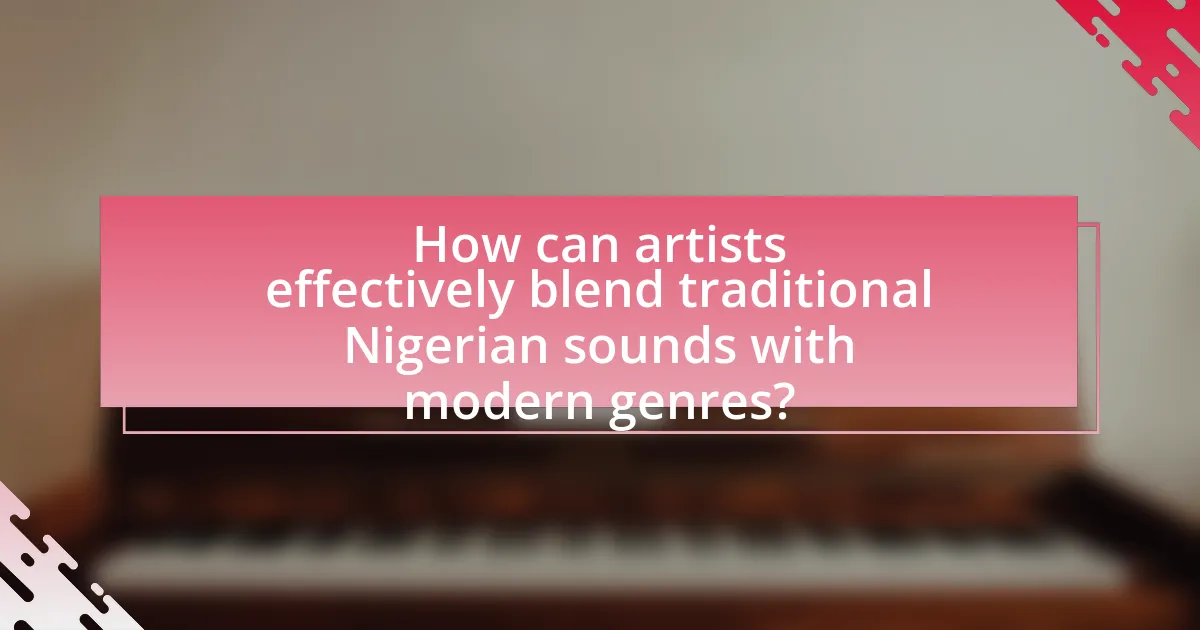
How can artists effectively blend traditional Nigerian sounds with modern genres?
Artists can effectively blend traditional Nigerian sounds with modern genres by incorporating indigenous instruments, rhythms, and melodies into contemporary music styles. For instance, using instruments like the talking drum or shekere alongside electronic beats creates a unique fusion that resonates with diverse audiences. Additionally, artists can draw on traditional vocal techniques and storytelling methods, which are integral to Nigerian music, to enhance the emotional depth of modern genres such as hip-hop or pop. This approach not only preserves cultural heritage but also appeals to global music trends, as seen in the rise of Afrobeats, which successfully merges traditional elements with modern production techniques.
What techniques can artists use to achieve a successful fusion?
Artists can achieve a successful fusion of traditional Nigerian sounds with modern genres by employing techniques such as blending instrumentation, incorporating rhythmic patterns, and utilizing vocal styles from both traditions. Blending instrumentation involves combining traditional Nigerian instruments like the talking drum or shekere with modern instruments such as synthesizers or electric guitars, creating a unique sound palette. Incorporating rhythmic patterns means integrating traditional African rhythms, which often feature complex polyrhythms, into contemporary music styles like hip-hop or pop, enhancing the overall groove. Utilizing vocal styles includes merging traditional singing techniques, such as call-and-response, with modern vocal delivery, allowing for a richer and more dynamic musical experience. These techniques have been effectively used by artists like Burna Boy and Wizkid, who successfully merge Afrobeat with global music trends, demonstrating the viability of this fusion approach.
How can understanding traditional music theory enhance modern compositions?
Understanding traditional music theory enhances modern compositions by providing a foundational framework that informs melody, harmony, and rhythm. This knowledge allows composers to draw from established techniques and cultural nuances, enriching their work with depth and authenticity. For instance, traditional Nigerian music often employs polyrhythms and call-and-response patterns, which can be integrated into contemporary genres to create innovative soundscapes. By studying these elements, modern composers can create pieces that resonate with both historical significance and contemporary appeal, thereby bridging cultural gaps and expanding their artistic expression.
What role does collaboration play in creating innovative music?
Collaboration plays a crucial role in creating innovative music by blending diverse musical influences and expertise. In the context of fusing traditional Nigerian sounds with modern genres, collaboration allows artists from different backgrounds to share their unique perspectives and techniques, resulting in a richer and more varied sound. For instance, Nigerian artists collaborating with musicians from genres like hip-hop, jazz, or electronic music can introduce new rhythms and instrumentation, enhancing the overall creativity of the music produced. This cross-pollination of ideas not only leads to innovative compositions but also helps in reaching wider audiences, as seen in the global popularity of Afrobeat, which emerged from such collaborative efforts.
What resources are available for artists interested in this fusion?
Artists interested in the fusion of traditional Nigerian sounds with modern genres can access various resources, including online platforms, workshops, and collaborative networks. Online platforms such as SoundCloud and Bandcamp allow artists to share their work and connect with audiences interested in this fusion. Workshops offered by organizations like the African Cultural Alliance of North America provide hands-on experience and guidance from experienced musicians. Collaborative networks, such as the Nigerian Music Industry Coalition, facilitate partnerships between traditional and contemporary artists, fostering innovation in music creation. These resources collectively support artists in exploring and developing their unique sound within this fusion genre.
Where can artists find traditional musicians to collaborate with?
Artists can find traditional musicians to collaborate with through local cultural festivals, music workshops, and online platforms dedicated to traditional music. Cultural festivals in Nigeria, such as the Calabar Carnival and the Osun-Osogbo Festival, often feature traditional musicians and provide opportunities for collaboration. Additionally, music workshops organized by cultural institutions or community centers can connect artists with traditional musicians. Online platforms like SoundCloud and Bandcamp also host profiles of traditional musicians, allowing artists to reach out for potential collaborations.
What educational programs focus on the fusion of traditional and modern music?
Educational programs that focus on the fusion of traditional and modern music include specialized courses in ethnomusicology, contemporary music studies, and world music programs offered by various universities. For instance, institutions like the University of Lagos and Obafemi Awolowo University in Nigeria provide programs that explore the integration of traditional Nigerian music with modern genres such as hip-hop, jazz, and electronic music. These programs often include practical workshops, performance opportunities, and research projects that emphasize the cultural significance and contemporary relevance of traditional sounds.
What are some best practices for promoting fused music?
To effectively promote fused music, artists should leverage social media platforms to reach diverse audiences, as these platforms allow for targeted marketing and engagement. Utilizing platforms like Instagram, TikTok, and YouTube can showcase music videos and behind-the-scenes content, which enhances visibility and connection with fans. Collaborating with influencers and other artists in both traditional and modern genres can also broaden reach and attract new listeners. Additionally, participating in music festivals and cultural events that celebrate fusion genres can provide exposure and networking opportunities. According to a report by the International Federation of the Phonographic Industry, social media is a key driver for music discovery, with 50% of listeners finding new music through these channels.
How can social media be leveraged to reach a wider audience?
Social media can be leveraged to reach a wider audience by utilizing targeted advertising, engaging content, and influencer partnerships. Targeted advertising allows creators to reach specific demographics interested in the fusion of traditional Nigerian sounds with modern genres, increasing visibility among potential fans. Engaging content, such as videos showcasing performances or behind-the-scenes footage, can capture attention and encourage shares, further expanding reach. Collaborating with influencers who resonate with the target audience can amplify messages and introduce the music to their followers, effectively broadening the audience base. According to a 2021 report by Hootsuite, social media advertising can increase brand awareness by up to 80%, demonstrating its effectiveness in reaching larger audiences.
What strategies can artists use to engage with both traditional and modern music fans?
Artists can engage with both traditional and modern music fans by blending traditional Nigerian sounds with contemporary genres, creating a unique fusion that appeals to diverse audiences. This strategy allows artists to honor cultural heritage while attracting modern listeners who appreciate innovation. For instance, collaborations between traditional musicians and contemporary artists can enhance visibility and reach, as seen in the success of artists like Burna Boy, who incorporates Afrobeat with elements of hip-hop and dancehall. Additionally, utilizing social media platforms to showcase live performances and behind-the-scenes content can bridge the gap between generations, fostering a community that values both traditional roots and modern expressions.
